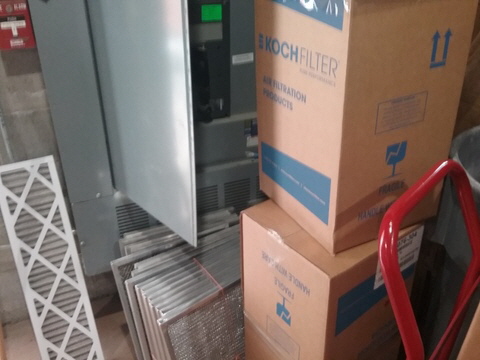The Hidden Electrical Panel
March 26, 2020

One gets to see all manner of things when you spend your time performing building inspections. That was, in fact, one of the inspirations for this series of publications. The hope is that by highlighting some of these issues, you can take a more critical look at the buildings in your portfolio and improve the way they are maintained. It is fitting, as we work through the COVID-19 virus and re-evaluate how we conduct ourselves with respect to personal hygiene and spacing to prevent the spread of this disease, that we take a moment to also re-think our buildings and perhaps not ignore those things that “have always been that way” because some of those situations can lead to truly disastrous problems if not addressed.
Case in point: what is wrong with this picture? Most, if not all of you, already know. Not only is it against code to have anything stored within 36″ of an electrical panel, but stacking flammable materials this close to panel or switchgear is just asking for trouble! Yet, of all of the problems observed in building, this (or a variation of it) is probably the most common. Why do we do it? Sometimes it is laziness. Sometimes our buildings are built with a lack of proper storage space, or that storage space is already full. Sometimes we tell ourselves that it is “just temporary” until we get those filters where they need to go. NONE of those would be acceptable answers of the fire marshal showed up for a pop inspection though, and we know it.
While we all know this is wrong and against NEC code, we continue to do so, often because we have been able to “get away with it” for so long in the past. We fool ourselves into thinking that it can’t be that bad because it has been that way for years, and I really don’t have any other place to put that stuff anyway. However, just as we are re-evaluating some of the social interactions that we are having to limit to prevent the spread of this virus, we now have to recognize that even though something doesn’t appear to be likely, if the potential for serious harm is high, we need to take the threat seriously.
Years ago, while managing a group of buildings nearby, we contracted a well known, national electrical contractor to perform some much needed / overdue preventive maintenance and service to our electrical switchgear. In watching the contractor go about his work, I was impressed by his commitment to safety. This was 1999, but he was wearing full arc-flash rated clothing and face protection, he made sure the work area was clear of obstructions and debris, and he made sure I was at a safe distance before he began his work, among other things. At the end of one work day, I complimented him on his commitment to safety. He shared that he hadn’t always been so cautious, but that the year prior, he lost a friend to a workplace accident involving arc-flash. They were leaving the work site and his co-worker noticed an unsecured panel on an overhead buss duct. They were in their street clothes, but his friend thought he could take the minute or two to re-secure the loose panel on their way out of the facility. He was wrong, and the arc-flash that caught him ignited his non-rated clothing. He died two weeks later from the burns he sustained.
I share that story because it is directly related to the picture above. While that isn’t a person standing in front of those panels, but it is certainly combustible material, and an arc-flash here could ignite those boxes and potentially the entire building.
This problem was addressed immediately when pointed out to the appropriate facilities maintenance personnel. How many times, though, have we seen the same or similar problems in our facilities? Electrical panels with cleaning supplies stored in front of them. Electrical panels with water lines that have been routed over them. Unsecured electrical panels in public spaces (especially in schools were children can access them). Too often, we walk right by these things because we don’t really “see” them – they have become the background ‘noise’ of our environment. Let’s take a moment and add this to our ‘to-do’ list and clean this stuff up. The building you save may be your own.
Do you have ideas on other topics for this feature? Post them in the comments on LinkedIn, Instagram, Twitter or Facebook.
